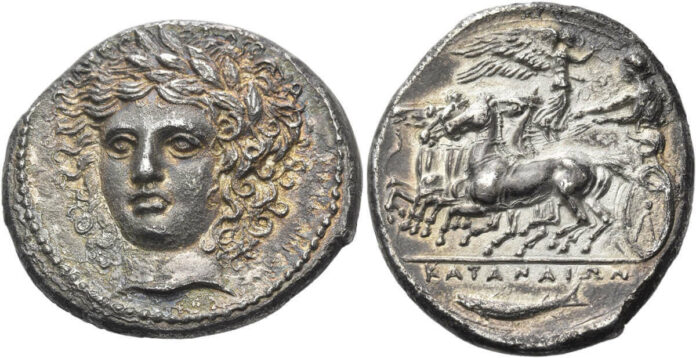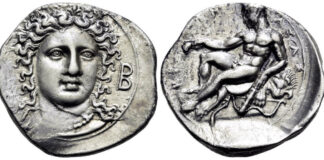Nomos 24 is Coming Up On 22 May
Yes, our latest auction is now online, and the catalogue itself is being printed and will soon be sent to everyone on our mailing list. There is quite an extensive and impressive selection of varied material coming from all parts of the ancient Classical World (including special collections from Epidauros and Roman Alexandria), Byzantine and Medieval coins and seals, and, even, an intriguing group of coins and medals of the 16th and 17th centuries. In other words, there really is something for everyone (unless, of course, your primary interest is in modern proof sets and NCLTs – though you wouldn’t be reading this if that were the case).
So without further ado, let’s look at a few Celtic and Greek pieces that have caught my eye today…
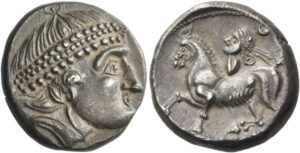
The first three lots of Auction 24 are all classed under the generic rubric of Celtic Coins: the first is a stater of the Namnetes of NW Gaul (Lot 1, Estimate: 5,000 CHF), the second a tetradrachm from the Middle Danube area (Lot 2, Estimate: 2,500 CHF), and the third an imitation of Thasos from somewhere in the area of present day Bulgaria or Rumania (Lot 3, Estimate: 500 CHF). What they have in common, and what seems terribly intriguing, is the way the human heads that appear on their obverses are treated: the first two are meant to be Apollo and the last Dionysos; but they certainly do not look like either Apollo or Dionysos! That brings up a question, which has been brought up before, but is always worth bringing up again: did the “Celtic” artists responsible for these heads produce them the way they did because they were incapable of doing them otherwise; because they wanted to do them that way for stylistic reasons; or, quite simply, because they saw people that way? And if they saw people that way, were they all on drugs?
A tetradrachm from Rhegion (Lot 11, Estimate: 15,000 CHF) that has a long and distinguished collection history. One reason for that must be its fortuitously attractive and curious shape: the types seem to be outlined and emphasized by the flan’s irregularities. As far as we know the coin first appeared in 1891 when it was bought from the Brighton coin dealer William Charles Weight by Sir Hermann Weber, who let Charles Seltman publish it in NC 1898; after his death it was sold through Spink to R. C. Lockett (in the sylloge this coin is 651, but it is illustrated with the obverse of 650 – and vice-versa); in the 1955 Lockett sale it sold for £105 to the great Swiss collector, A. Moretti (1907-1993). Well after Moretti’s death it was sold in 1998 at Triton II, subsequently ending up in the collection of the German who is selling it now.
Lot 18 is a tetradrachm from the city of Katane in Sicily; it was struck at some point during the 450s BC (Lot 18, Estimate: 40,000 CHF), and has the river god Amenanos, depicted as a man-headed bull, on the obverse and, on the reverse, a figure of Nike walking to the left. Artistically this is quite an interesting coin since it stands at the border between the stiffness of Archaic art and the greater fluidity and freedom of the Classical period: the very well engraved head of the river god still has a completely frontal eye, while Nike wears an apparently diaphanous chiton with an equally diaphanous peplos; and there is a heron who is both stately and naturalistic. It is characteristic of this whole group of Amenanos/Nike tetradrachms that while the quality of the die engraving is ambitious, the ability of the mint workers to strike coins equally well was definitely not! Many of the preserved pieces are notoriously badly struck, often on defective flans. This piece shows some of those defects, but only in a relatively minor way, and is, thus, not only very rare but unusually nice.
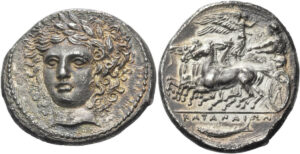
What a difference 50 years can make! This tetradrachm, engraved by the artist Herakleidas, and minted in Katane in c. 405-403/2 BC (Lot 19, Estimate: 150,000 CHF), bears types of a style and quality of execution that place them among the absolute highlights of late 5th century numismatic art. The head of Apollo on the obverse, once disfigured by corrosion products, now radiates a stunning, truly divine, handsomeness that makes it one of the greatest of all the facing heads to ever to appear on an ancient Greek coin. Yet he does seem to be an approachable god, one who just might be able to act in an informal, friendly, way. As for the reverse, the galloping quadriga is as well-made as any appearing on late 5th century Sicilian coinage – but do note the skill by which the veins and muscles on the near horse’s belly are made; the full-sized Nike hovering over the horses is a real triumph too!
The facing head of Apollo on the previous coin is one of a god who was surely fully conscious of his divine power, but one who could also show forgiveness, understanding and, probably, a restrained sense of humor. Now we have a facing head of Hermes who has a much sterner, much more serious expression (Lot 43, estimate: 30,000 CHF). He actually looks as if some mortal has dared to ask for a favor that he definitely does not want to grant: could it be that he is unable to grant it, and that makes him angry? Yet he is also a youth of great elegance, coupled with a healthy dose of arrogance. In short, struck from dies engraved at roughly the same time as those for the Katane, it is another absolutely brilliant facing head. And on the other side we have a very accomplished and, even, lightly humorous and naturalistic rendering, of Ainos’s traditional goat reverse type: here the goat is enjoying a light snack of ivy leaves, carefully placed in an amphora!
The goddess whose head appears on the staters of Corinth, and on those of the other cities that used the type is always helmeted: in 1996 Peter Blomberg published a very convincing study maintaining that she was probably Aphrodite (On Corinthian Iconography, Boreas 25, Uppsala, 1996). This theory was accepted by many. However, just two days ago (!) when the latest Numismatic Chronicle (Vol. 181, 2021) arrived in my mail box, it included an article that completely disproved Blomberg’s theory: L.L. Brice & A. Ziskowski, Athena, Peirene and Pegasi: Myth and Identity in Corinthian Numismatics, pp. 1-16. We will discuss this in greater detail next time. The one thing that all of the heads (i.e., Athena heads) have in common is that their helmet lacks a crest; except in very rare cases, as here, on a stater struck in Ambrakia, c. 360-338 BC (Lot 82, estimate: 2,500 CHF). Exactly why this should be the case is unclear; in addition, the goddess’s head shown here is a particularly elegant one!
As we have seen, the goddess very rarely wears a crested Corinthian helmet; in the same way, Pegasos is almost invariably shown flying (as on lot 82 above); but sometimes, of course, he isn’t. Here are two variant versions of Pegasos, the first being exceptionally rare. The present piece (Lot 116, Estimate: 3,500 CHF), a stater from Corinth given the general date of c. 405-345 BC, bears a very unusual depiction of Pegasos, which is instantly reminiscent of some contemporary issues from Larissa: where he is preparing to roll over! Of course, while the Thessalian animal is merely a simple horse, so rolling over would not be too difficult, what would happen to Pegasos’s wings? In the article by Brice and Ziskowski, cited above, it is suggested that he is actually drinking from the fountain of Peirene, where he was bridled and tamed by Bellerophon, who then rode him when he successfully killed the monster Chimaera.
Also dating to c. 405-345 BC, this Corinthian piece shows us Pegasos walking to left (note the ground line – also appearing on lot 116 – he is clearly not flying) in a very stately way (Lot 117, Estimate: 1,200 CHF). What is interesting is that Pegasos’s wing is shown curled, which is a rather archaizing feature that one would have expected to see on a Corinthian stater nearly 150 years earlier. It may be that the engraver was uncertain of how to show a wing that was not in use for flying!

This is an extremely rare heavy weight Apollo/Asklepios drachm from Epidauros, one of the real highlights of the Maleatas Collection of Epidauros, which appears in its entirety in Nomos 24 (Lot 129, Estimate: 9,500 CHF). Not only is this an extremely important coin in itself (it is apparently the second of two known), it is also very unusual because of its weight, which is that of a slightly light Aeginetic drachm. This is because this type is commonly known as a drachm struck on a weight standard that can either be termed reduced weight Aeginetic or, somewhat improbably, as being of slightly heavy Attic weight (as Lot 132 in this sale, which is struck from the same obverse die as the present piece). This can only have happened because the minting authorities decided to change the weight standard without changing the types, which is exactly what they did in Epidauros. As such, this is extremely rare both as a coin and as a clear example of an ongoing monetary reform!
Two Provenance Corrections
This is a very rare drachm from the north African city of Euhesperides dating to c. 450 BC (Lot 265, Estimate: 14,000 CHF); the city was founded in the 6th century, had some importance during the 5th and 4th centuries, was semi-abandoned in 275 BC, and refunded as Berenike in 245 (the city was moved because its harbor began to silt up). While the city walls were repaired by Justinian, it had lost almost all importance as a city by early Islamic times. Thanks to the tireless research of our Australian colleague, we have now learned that this lovely piece also formed part of the collections of both the Comtesse de Béhague and E. P. Warren!
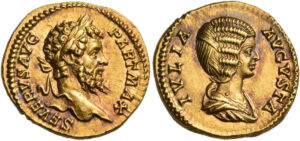
And now we have an even bigger jump – caused by the fact that sometimes coins, which seem to look the same, actually are not! This wonderful aureus of Septimius Severus and Julia Domna (lot 417, estimated at 75,000 CHF) was given a provenance in our catalogue that included the Biaggi, Platt Hall and Vautier collections – unfortunately completely incorrect! That coin is a very, very, similar piece; in fact, so similar that our expert cataloguer became befuddled, bedazzled and discombobulated by the (incorrect) Biaggi provenance given in NAC 52 in 2009 for the present coin and cited it in our catalogue. In fact, this coin did not come from Biaggi at all, it came from NFA XXVI in 1991 where it was correctly noted as having been in the Brand Collection (part 3, Sotheby Zurich, 1983, lot 368)! Brand bought it from Spink in 1910, and Spink got it from the Cologne Hoard of 1909!
To view all lots of the auction, visit the online catalog.
For further information about the auction house, visit the website of Nomos AG.




